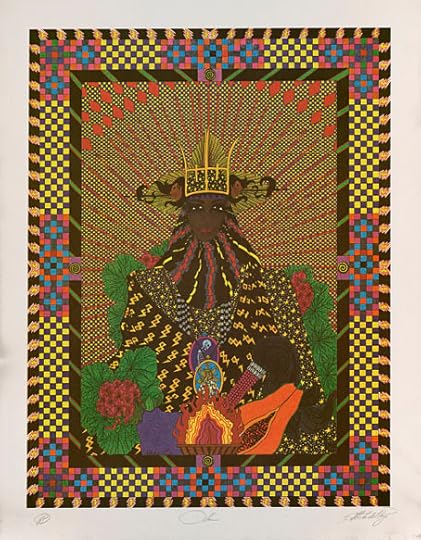John Coulthart's Blog, page 310
May 15, 2011
Origami tessellations
I seldom try origami these days despite an enthusiasm for it when I was younger, but I still like to see how people are developing the artform. These tessellation designs are part of a sub-genre of abstract paper-folding that's a long way from the traditional Japanese animal shapes. The examples here are by Ray Schamp from his Flickr set. There are many more examples at the Origami Tessellations Flickr pool.
Previously on { feuilleton }
• Sipho Mabona's origami insects
• Robert Lang's origami insects
May 14, 2011
Weekend links

Or So It Seems (1983) by Duet Emmo. Design by The Brothers Quay.
• "Make things, no rules, but be quick." Bruce Gilbert, musician in (among others) Wire, Dome and Duet Emmo is interviewed. Related: Daniel Miller, Mute label boss and another member of Duet Emmo is interviewed (and provides a mix) at The Quietus. For more electronica with nothing at all to do with Duet Emmo there's this Matmos interview.

Design by Dick Smith.
"It's psychedelic not because we were stoned before we wrote the songs, or stoned during composing them, but the experiences of searching for the transcendental world though altered states of consciousness were in the songs," he says, which sounds suspiciously like another way of saying he was stoned before he wrote them, but perhaps it's best not to quibble with the description of the method in the face of such impressive results…
Donovan revisits one of his finest works, Sunshine Superman.
• Yet more Guardian features: A Clockwork Orange: The droog rides again | Ira Cohen: psychedelic photography master | A life in writing: China Miéville | The stars of modern SF pick the best science fiction.
• There are many stars of the gaseous variety in Nick Risinger's 5000-megapixel photograph of the Milky Way.
"It is quite true I have worshipped you with far more romance of feeling than a man should ever give to a friend. Somehow I have never loved a woman…. From the moment I met you, your personality had the most extraordinary influence over me…. I adored you madly, extravagantly, absurdly. I was jealous of everyone to whom you spoke. I wanted to have you all to myself. I was only happy when I was with you."
Salon reviews the new unexpurgated edition of The Picture of Dorian Gray.
• Paul Gorman discovered the gay art origins of the notorious Cowboys T-shirt.
• The full complement of Saul Bass's designs for Vertigo's print advertising.
• Photos of the recent Dodgem Logic event by Rosie Reed Gold.
• Peter Ashworth is still taking great photos.
• Jodorowsky's Dune Finally Revealed?
• Sunshine Superman (1966) by Donovan | Or So It Seems (1983) by Duet Emmo.
May 13, 2011
The Divine Eros Defeats the Earthly Eros
Another favourite painting receiving the Google Art Project high-res treatment. Giovanni Baglione's picture (also known as Sacred Love versus Profane Love) was painted circa 1602 as a riposte to Caravaggio's provocative Amor Vincit Omnia. Where Caravaggio showed Eros triumphing over worldly concerns Baglione gives us an image of religious propaganda which displeased the older artist. Salt was rubbed in the wounds when Baglione produced a second (and lesser) version which puts Caravaggio's features on the figure of the Devil. There's an irony in this spat in the way that Baglione's noble aspiration is subverted by erotic tension, the victorious angel shown happily astride a vulnerable and capitulating youth. If someone had pointed this out to Caravaggio he might not have felt so aggrieved.
Both Amor Vincit Omnia and The Divine Eros Defeats the Earthly Eros are part of the Old Master collection at the Gemäldegalerie, Berlin, where they can be viewed side by side.
Previously on { feuilleton }
• Chiaroscuro
• Angels 1: The Angel of History and sensual metaphysics
May 12, 2011
Deutsche Kunst und Dekoration #23

An exhibition of Wiener Werkstätte posters and graphics.
Continuing the delve into back numbers of Deutsche Kunst und Dekoration, the German periodical of art and decoration. Volume 23 covers the period from October 1908 to March 1909, and aside from some dull paintings the Wiener Werkstätte continue to dominate proceedings with photographs and graphics from exhibitions of their work; the slow evolution towards Art Deco continues.
As usual, anyone wishing to see these samples in greater detail is advised to download the entire number at the Internet Archive. There'll be more DK&D next week.

Gustav Klimt turns up again with his most famous work, The Kiss, which is here named Liebespaar.


Above and following below, graphics by Emanuel Margold.






Above are poster designs by Carl Otto Czeschka and Franz Zeymer while below is a remarkably elaborate vitrine by Czeschka made from silver and embellished with enamel and moonstones. A much larger, colour view of its present state can be found here.


One of a number of very detailed drawings from a feature on Annie French, a member of the Glasgow Arts and Crafts movement. There's a small collection of her works here which benefit from being seen in colour.

And another gay artist is featured (although there won't be any acknowledgement of that). This is a depiction of that perennial gay art theme, Ganymede, by Hans von Marées.

Previously on { feuilleton }
• Deutsche Kunst und Dekoration #22
• Deutsche Kunst und Dekoration #21
• Deutsche Kunst und Dekoration #20
• Deutsche Kunst und Dekoration #19
• Deutsche Kunst und Dekoration #18
• Deutsche Kunst und Dekoration #16
• Deutsche Kunst und Dekoration #15
• Deutsche Kunst und Dekoration #12
• Deutsche Kunst und Dekoration #11
• Deutsche Kunst und Dekoration #10: Turin and Vienna
• Deutsche Kunst und Dekoration #10: Heinrich Vogeler
• Deutsche Kunst und Dekoration #9
• Deutsche Kunst und Dekoration #8
• Deutsche Kunst und Dekoration #7
• Deutsche Kunst und Dekoration #6
• Deutsche Kunst und Dekoration #5
• Deutsche Kunst und Dekoration #4
• Deutsche Kunst und Dekoration #2
• Deutsche Kunst und Dekoration #1
• Deutsche Kunst und Dekoration
• Keim & Czeschka's Nibelungen
• Jugend Magazine revisited
May 11, 2011
San Francisco by Anthony Stern
The flip-side of the kitsch London of Smashing Time can be found in this frenetic short made a year later which presents a fragmented view of that other locus of the Paisley Era, San Francisco. Director Anthony Stern avoids the usual longueurs of silent documentary by chopping his footage to bits to create a tour through the city streets that's as frenzied as the films of Jeff Keen. The bonus is a score by The Pink Floyd (from the days when they still used the definite article) playing an exclusive version of Interstellar Overdrive. That alone makes one wonder why this film hasn't received more attention over the years.
Stern's film reminds me of Kenneth Anger's Invocation of My Demon Brother (1969), another short work which is frequently as frenzied and also features scenes filmed in San Francisco. In addition, both films feature some ritual business: Stern shows a group of freaks in a psychedelic house with the inevitable naked woman cavorting for the benefit of clothed men; Anger is rather more serious with shots of a full-blown Crowlean ceremony. Anthony Stern today has established himself as a very accomplished glass artist; you can see his glass work here and watch San Francisco here.
Previously on { feuilleton }
• Smashing Time
• Berlin Horse and Marvo Movie
• Kenneth Anger on DVD again
May 10, 2011
Return of the Triumphant Phallus

The Triumph of the Phallus (1700–1750).
More phallic culture. I posted the above engraving a couple of years ago, an unattributed copy of a drawing by Francesco Salviati (1510–1563) which shows in three panels a giant phallus being driven by a festive crowd towards an equally prodigious vaginal opening. (See the three panels in full here.) A few months after that post I wrote something about British underground artist Jim Leon and failed at the time to notice that Leon had reworked the Salviati procession for a painting used in issue 36 of Oz magazine (July 1971).

As is evident, here, the magazine editors carefully cropped Leon's art to avoid stretching the patience of distributors and vendors. The complete work was printed over two pages inside but in a two-colour version which is less than satisfactory. This issue of the magazine also featured Leon's far more incendiary Necrophilia piece which was the one I selected for my earlier post. What finally made me recognise the link between Leon and Salviati was a posting of Leon's original painting on the Maggs Counterculture Tumblr (below).
Leon shortened the procession but follows the rest of the picture very closely. Given the reversal of Leon's version it's possible he may have traced an outline as a guide before starting work, some of the details are a precise match. Oz magazine, it should be noted, was aimed at a general readership yet frequently published erotic art by Leon and others in this kind of matter-of-fact manner, something that's difficult to imagine anyone doing today outside the porn world. Think about that next time someone asserts that we're living in an unprecedentedly over-sexed era. You can see the whole of Oz #36 here.
Previously on { feuilleton }
• The Choise of Valentines, Or the Merie Ballad of Nash His Dildo
• The art of Jim Leon, 1938–2002
• The fascinating phallus
• The Triumph of the Phallus
• Le Phallus phénoménal
• Phallic bibelots
• The New Love Poetry
• Phallic worship
• The art of ejaculation
May 9, 2011
Smashing Time
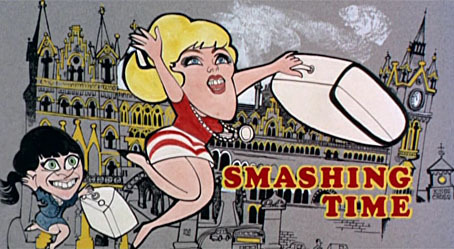
Writing about the late Lynn Redgrave last year I picked out this film as a career highlight despite not having seen it for a very long time. Watching it again recently was an interesting experience, not least for the way it connects to more recent points of obsession, none of them obvious the first time round.
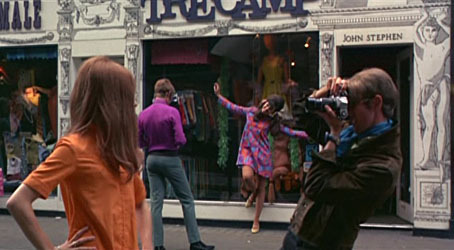
Carnaby Street antics.
Smashing Time was directed by Desmond Davies in 1967, and the direction is as perfunctory as you'd expect from someone whose career before and after was mostly for television. Of more interest is the script by George Melly, a bisexual jazz singer, writer, and lifelong evangelist for Surrealist art. This was his first job as a screenwriter and he seems an odd choice; he was 41 at the time, and his portrayal of Swinging London and its denizens is often typical of the acerbic older generation's view of the younger groovers. It's never as cynical as the Private Eye crowd but without Melly's humour the tone might seem patronising. That said, it was the satire magazine that originated the names of the two lead characters, Brenda (Rita Tushingham) and Yvonne (Lynn Redgrave) being Private Eye's names for Queen Elizabeth and Princess Margaret respectively. The story is a simple one of the pair coming to London from the north of England in search of "a smashing time", and, in Yvonne's case, an attempt to make it big somehow. Misadventures ensue.
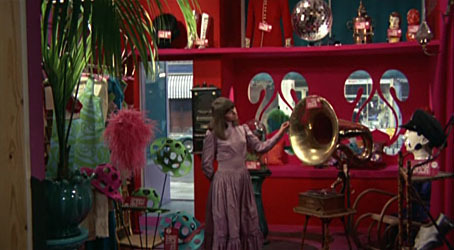
Brenda in the Too Much boutique.
Along the way there are digs at avant garde artists, lecherous men, greedy pop promoters and wealthy boutique owners. Melly leavens his barbs with yet another example of the Lewis Carroll influence on late-60s culture. There's a scene in the Jabberwock Gallery and a host of Jabberwocky-derived character names: Tom Wabe (Michael York), Charlotte Brillig, Mrs Gimble (the always wonderful Irene Handl), Bobby Mome-Rath (Ian Carmichael) and Jeremy Tove. There's also an Alice Boojum and a band named The Snarks (real-life psych band Tomorrow) who don't get to play, unfortunately. Tomorrow, who appear in the final party scene, are the sole connection with the genuinely hip London of 1967. Everything else we see is the Sunday supplement view of the city with Carnaby Street, shots of Chelsea and a dishevelled Camden, ending with that bright new landmark of 1960s London, the Post Office Tower.
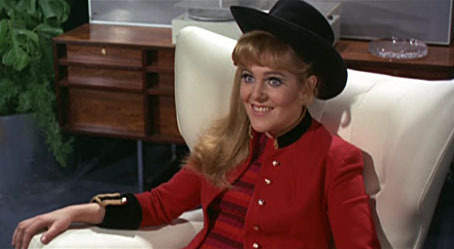
Yvonne begins her pop career.
My childhood enthusiasm was obviously taken with the film's superficial qualities—there are so many songs it's almost a musical—whereas now I'm impatient with the laboured slapstick but enjoy all the peripheral stuff. Many of the documentary shots of streets away from the centre are a reminder of how shabby and grimy the capital really was at that time, as was the rest of Britain when there was still a century of industrial soot on the walls. I also realise I'd missed the double-meaning of the title: "smashing time" isn't only a modish phrase for an enjoyable experience but a nod to the way Brenda and Yvonne cause havoc wherever they go. The jabs from an older musician at brainless pop culture would have annoyed some but Yvonne's hit song, I'm So Young (which is actually very good), has lyrics which resonate today:
I can't sing but I'm young
I can't do a thing but I'm young
I'm a fool
But I'm cool
Don't put me down
Lynne Redgrave is fantastic as Yvonne, completely convincing in a part which requires her to be loud, selfish and petulant without ever being too obnoxious. She also wears a different wig in nearly every scene. Among other moments of note there's some fleeting gay humour with a pair of waiters camping it up in the Sweeney Todd pie shop (as does Murray Melvin in another scene). And there's also an incident which, being an Aubrey Beardsley obsessive, I have to draw attention to:
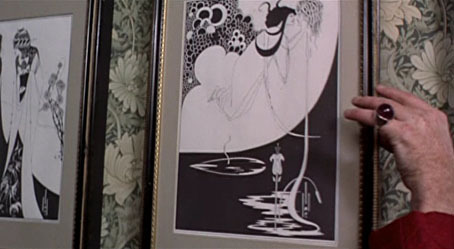
Was this the first appearance of Beardsley's work in cinema? The V&A exhibition which began the Beardsley revival had taken place only a year before, and I can't think of any examples earlier than this. The William Morris wallpaper is a fitting touch as well.
Reservations aside, this is a film I could watch more often than "properly" psychedelic fare like Wonderwall. For a snapshot of the period, it's still a smash, baby.
Previously on { feuilleton }
• Lynn Redgrave, 1943–2010
• Through the Wonderwall
May 8, 2011
Lonesome Cowboys
Years before Brokeback Mountain, and a few years before The Place of Dead Roads, another pair of gay cowboys were causing a stir on a T-shirt in the SEX boutique, London, a shop run by Malcolm McLaren and Vivienne Westwood in the mid-70s. Paul Gorman's latest piece of pop archaeology examines the history and possible genesis of this shirt, one of a number designed by McLaren whose challenging nature made them ideal gear for the first wave of London's punks. SEX specialised in transgression (and was famously the birthplace of the Sex Pistols), selling fetish and bondage clothing, and with a variety of erotic material on its hand-made shirts. But it was the Cowboys image which caused the most fuss in 1975 when the shop-owners were prosecuted for "exposing to public view an indecent exhibition", a piece of police action that was all-too-common in the 1970s especially where punks were concerned. McLaren's cowboys might seem quaint today but in 1975 this was a shocking image for a country which had only decriminalised homosexual acts eight years before, and where the only gay people in the media (although they never admitted it) were camp comedians and flamboyant sitcom stereotypes.
So much for the history but we still don't know the origin of the picture. Paul has his own theories; mine would be that McLaren borrowed this from one of the many gay mags which proliferated post-Stonewall. It's not a Tom of Finland drawing, and it's not George Quaintance either, an artist who drew many naked cowboys but never showed any genitalia. If anyone knows the artist responsible, or even the original source of the picture, please leave a comment. Vivienne Westwood still sells a version of the shirt: yours for ninety quid, dearie. Meanwhile, you can see a couple of the original Lonesome Cowboys here.
Elsewhere on { feuilleton }
• The gay artists archive
May 7, 2011
Weekend links
Oya by Alberto del Pozo (1945–1992). Also known as Yansa, Oya is Changó's third wife. She is the goddess of the winds and of lightning and is mistress of the cemetery gates. Passionate and brave she fights by her husband's side if needed. Her favorite offerings are papaya, eggplant and geraniums. From Santeria at BibliOdyssey.
Austin Osman Spare is a good example of the dictum that quality will out in the end, no matter how long it remains buried. Overlooked by the art establishment after he retreated into his private mythologies, a substantial portion of his output was equally ignored by occultists who wanted to preserve him as a weird and scary working-class magus. One group dismissed his deeply-felt spiritual interests in a manner they wouldn't dare employ if he'd been a follower of Santeria, say (or even a devout Christian), while the other group seemed to regard his superb portraits as too mundane to be worthy of attention. Now that Phil Baker's Spare biography has been published by Strange Attractor we might have reached the end of such short-sighted appraisals and can finally see a more rounded picture of the man and his work:
[Kenneth] Grant preserved and magnified Spare's own tendency to confabulation, giving him the starring role in stories further influenced by Grant's own reading of visionary and pulp writers such as Arthur Machen, HP Lovecraft, and Fu Manchu creator Sax Rohmer. Grant's Spare seems to inhabit a parallel London; a city with an alchemist in Islington, a mysterious Chinese dream-control cult in Stockwell, and a small shop with a labyrinthine basement complex, its grottoes decorated by Spare, where a magical lodge holds meetings. This shop – then a furrier, now an Islamic bookshop, near Baker Street – really existed, and part of the fascination of Grant's version of Spare's London is its misty overlap with reality.
Austin Osman Spare: Cockney visionary by Phil Baker.
• Austin Osman Spare: The man art history left behind | A Flickr set: Austin Osman Spare at the Cuming Museum | HV Morton meets Austin Spare (1927).
• More quality rising from obscurity: Jerzy Skolimowski's Deep End. Skolimowski's drama is one of unpleasant characters behaving badly towards each other. Anglo-American cinema featured a great deal of this in the 1970s when filmmakers disregarded the sympathies of their audience in a manner which would be difficult today. John Patterson looks at another example which is also given a re-release this month, the "feral, minatory and menacing masterwork" that is Taxi Driver.
Echú Eleguá by Alberto del Pozo. Among the most ancient of the orishas Echú Eleguá is the messenger of the gods, who forges roads, protects the house, and is heaven's gate-keeper. In any ceremony he is invoked first. He owns all cowrie shells and is the god of luck. A prankster, Echú Eleguá frequently has a monkey and a black rooster by his side. Like a mischievous boy he enjoys gossip and must be pampered with offerings of toys, fruit, and candy.
• Minutes, a compilation on the LTM label from 1987: William Burroughs, Jean Cocteau, Tuxedomoon, Jacques Derrida, The Monochrome Set, and er…Richard Jobson. Thomi Wroblewski designed covers for a number of Burroughs titles in the 1980s, and he also provided the cover art for this release.
• Mikel Marton Photography: a Tumblr of erotic photography and self-portraits.
• From Death Factory To Norfolk Fens: Chris & Cosey interviewed.
• NASA announces results of epic space-time experiment.
• Oritsunagumono by Takayuki Hori: origami x-rays.
• Plexus magazine at 50 Watts.
• Mother Sky (1970) by Can | Late For The Sky (1974) by Jackson Browne.
May 6, 2011
Deutsche Kunst und Dekoration #22

Continuing the delve into back numbers of Deutsche Kunst und Dekoration, the German periodical of art and decoration. Volume 22 covers the period from April 1908 to September 1908, and the highlight of this issue is a series of ink drawings (above and below) by Carl Otto Czeschka, another member of the Wiener Werkstätte. Also in this edition is a feature on Gustav Klimt's controversial Faculty Paintings. As usual, anyone wishing to see these samples in greater detail is advised to download the entire number at the Internet Archive. There'll be more DK&D next week.










Klimt's Faculty series was created for the University of Vienna's Great Hall. The profusion of naked bodies and sinister females proved too much for the staid members of the faculty, and Klimt was accused of producing pornography. The Jurisprudence panel (above) is one of the strangest of all his works, with three women representing the Furies presiding over a condemned man ensnared by an octopus, a common creature in Japanese art but very rare in Western art up to this time. We only ever see black-and-white reproductions of the complete paintings as they were destroyed by the SS in 1945.





More Wiener Werkstätte with a feature on the newly-built Mathildenhöhe, Darmstadt, designed by Joseph Maria Olbrich. The very distinctive tower is known as the Hochzeitsturm, or Wedding Tower, named to commemorate the wedding of Grand Duke Ernst Ludwig of Darmstadt in 1905.
Previously on { feuilleton }
• Deutsche Kunst und Dekoration #21
• Deutsche Kunst und Dekoration #20
• Deutsche Kunst und Dekoration #19
• Deutsche Kunst und Dekoration #18
• Deutsche Kunst und Dekoration #16
• Deutsche Kunst und Dekoration #15
• Deutsche Kunst und Dekoration #12
• Deutsche Kunst und Dekoration #11
• Deutsche Kunst und Dekoration #10: Turin and Vienna
• Deutsche Kunst und Dekoration #10: Heinrich Vogeler
• Deutsche Kunst und Dekoration #9
• Deutsche Kunst und Dekoration #8
• Deutsche Kunst und Dekoration #7
• Deutsche Kunst und Dekoration #6
• Deutsche Kunst und Dekoration #5
• Deutsche Kunst und Dekoration #4
• Deutsche Kunst und Dekoration #2
• Deutsche Kunst und Dekoration #1
• Deutsche Kunst und Dekoration
• Keim & Czeschka's Nibelungen
• Jugend Magazine revisited
John Coulthart's Blog
- John Coulthart's profile
- 31 followers









